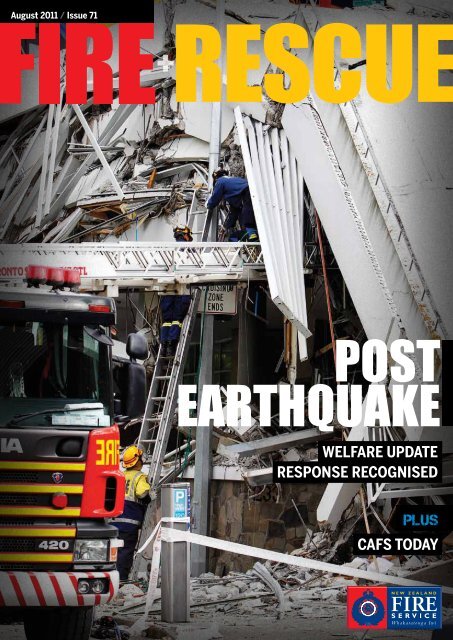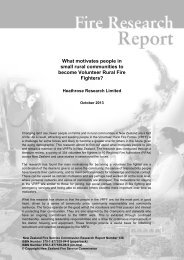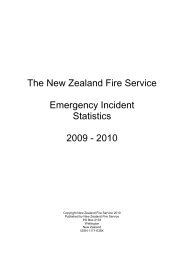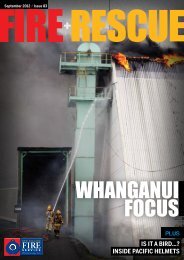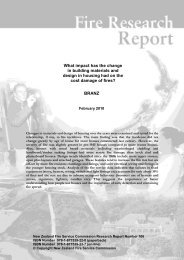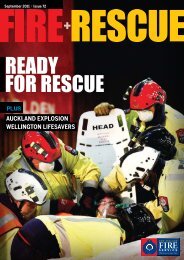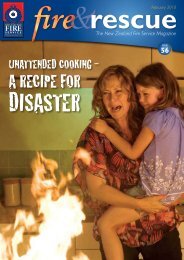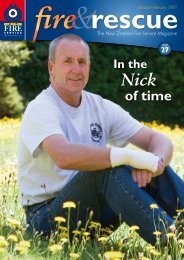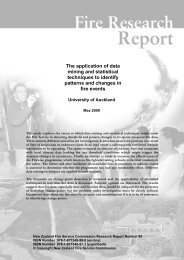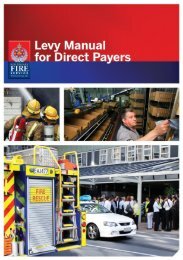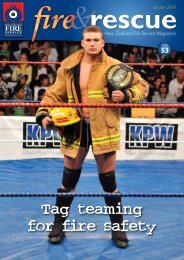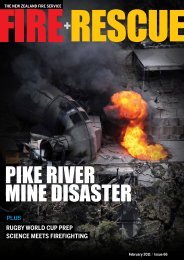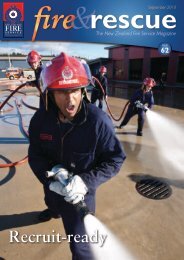Issue 71 - New Zealand Fire Service
Issue 71 - New Zealand Fire Service
Issue 71 - New Zealand Fire Service
Create successful ePaper yourself
Turn your PDF publications into a flip-book with our unique Google optimized e-Paper software.
august 2011 / issue <strong>71</strong><br />
POST<br />
earThquake<br />
Welfare update<br />
response recognised<br />
Plus<br />
cafs today
the neW zealand fire service<br />
<strong>Fire</strong>+Rescue is the flagship<br />
publication of the <strong>New</strong> <strong>Zealand</strong><br />
<strong>Fire</strong> <strong>Service</strong>.<br />
It is produced by Media,<br />
Promotions and Communications,<br />
National Headquarters,<br />
Level 9, 80 The Terrace, Wellington.<br />
contributions to fire+rescue<br />
We welcome ideas for articles, news<br />
and events that would be of interest to<br />
other <strong>Fire</strong> <strong>Service</strong> staff and volunteers.<br />
Draft articles and photos (pictures<br />
need to be at least 1MB) can be<br />
emailed to fire.rescue@fire.org.nz or<br />
contact the editor Karlum Lattimore<br />
on 04 496 3702.<br />
Post written material and photos,<br />
or photo CDs to:<br />
<strong>Fire</strong>+Rescue magazine,<br />
PO Box 2133, Wellington.<br />
(These will be returned on request.)<br />
WWW.fire.org.nz<br />
All material in <strong>Fire</strong>+Rescue magazine<br />
is copyrighted and may not be<br />
reproduced without the permission<br />
of the editor.<br />
ISSN: 1176-6670 (Print)<br />
ISSN: 1177-8679 (Online)<br />
front cover<br />
Police and firefighters work to<br />
rescue a trapped woman after<br />
the building she was in collapsed<br />
in the CBD after the 6.3 ’quake,<br />
Christchurch, <strong>New</strong> <strong>Zealand</strong>.<br />
Photo: NZPA/Wayne Drought.<br />
2 / <strong>Fire</strong>+Rescue / August 2011<br />
Good call<br />
A bit of smoke and some sleuthing has uncovered<br />
a potentially serious problem with a particular type<br />
of bathroom heater.<br />
It has also revealed the importance of calling in the experts whenever a faulty<br />
appliance starts sending out smoke signals, or worse still, causes a fire.<br />
Back in May, Sockburn Senior Station Officer John Baxter and his crew responded<br />
to a call from a man whose Goldair bathroom wall-mounted heater had started smoking.<br />
“The plastic surround of the heater had caught fire and it went out when the owner<br />
turned it off, as it’s designed to do.”<br />
John said he got into conversation with a next door neighbour who told him she had had<br />
the same thing happen with her heater, also a Goldair model 3180 fan heater. He promptly<br />
called in Mid Canterbury <strong>Fire</strong> Safety Officer Joe Hefford and they went and checked on<br />
other neighbours, who all lived in homes built and equipped by the same company.<br />
They found one more resident with a heater that was showing signs of the same problem<br />
– so Energy Safety was alerted.<br />
Joe Hefford said, “Heaters don’t fail and catch fire unless there’s something wrong so we<br />
encourage firefighters attending these sorts of incidents to call us in. They should also<br />
notify Energy Safety directly themselves.”<br />
Energy Safety is responsible for monitoring the safety of gas and electrical appliances<br />
and investigating any potential problems and the <strong>Fire</strong> <strong>Service</strong> is legally obliged to notify<br />
them of any products that have caused a fire. An Energy Safety inspector has examined<br />
the heaters and determined there is either a common fault in the terminal block<br />
component of the appliance, or they were installed incorrectly.<br />
The suppliers are carrying out their own investigation, looking closely at whether there is<br />
a fault, and if it is similar to the failure in an earlier model of the heater that forced a recall.<br />
Top: John Baxter and Jim Hefford.
teaching<br />
self-reliance<br />
In a major disaster, most people will have to help themselves and those closest<br />
to them for the first day or so until emergency services can reach them.<br />
The February earthquake in<br />
Christchurch brought this message<br />
home to Timaru.<br />
As a result, local agencies, including the<br />
<strong>Fire</strong> <strong>Service</strong>, have adapted the Neighbour<br />
Emergency Response Training (NERT)<br />
concept that was developed out of the<br />
1989 San Francisco earthquake. During the<br />
training, different services teach emergency<br />
self-help techniques to the public.<br />
Timaru Assistant Area Manager (Acting)<br />
Phil de Joux said, “Representatives from<br />
the <strong>Fire</strong> <strong>Service</strong>, Civil Defence, Alpine<br />
Energy, Community and Public Health,<br />
Police and St John Ambulance met<br />
to discuss what information and skills<br />
they could offer the public to help them<br />
get through the first 24 hours of an<br />
emergency without any outside help.”<br />
The agencies hosted a half-day workshop<br />
at the Timaru <strong>Fire</strong> Station offering<br />
members of the public practical training<br />
in basic first aid, light rescues and safe<br />
ladder work, basic firefighting and<br />
extinguisher training, how to assemble<br />
an emergency get thru kit and how<br />
to avoid infection and disease spread.<br />
There were also discussions on how<br />
to deal with power and gas supplies,<br />
hazardous materials in the home<br />
and general security issues.<br />
The workshop was advertised in the local<br />
media and promoted by speakers at<br />
various community organisations.<br />
Phil said feedback was very positive.<br />
“We had 90 people take part in the pilot<br />
workshop and everybody went home<br />
having learnt something that would better<br />
prepare them for any natural disaster they<br />
might be involved in. They now know how<br />
to minimise damage to their properties<br />
and possibly save their own or a<br />
neighbour’s life.”<br />
Everyone who attended was equipped<br />
with relevant pamphlets and some of<br />
the items they will need to set up an<br />
emergency kit.<br />
Phil says this type of training could easily<br />
be undertaken by other communities<br />
around the country and the Christchurch<br />
City Council has shown keen interest in<br />
the concept. He says NERT will continue<br />
to be promoted to the public in Timaru<br />
and he expects more training workshops<br />
to be held.<br />
Below: Phil de Joux welcomes the crowd. Right: <strong>Fire</strong>fighters from USAR Taskforce 2 team show how to rescue someone from under a vehicle.<br />
Bottom right: <strong>Fire</strong>fighters from USAR Taskforce 2 demonstrate how to use blocks and a lever to lift heavy objects.<br />
out and about<br />
<strong>Fire</strong>+Rescue / August 2011 / 3
feature<br />
one year on<br />
Almost a year has passed since the first major earthquake in Canterbury but for<br />
<strong>Fire</strong> <strong>Service</strong> personnel in the area it has seemed much longer.<br />
Continual aftershocks, the<br />
devastating ’quake in February and<br />
another harsh jolt in June have all<br />
left their mark. There has been continual<br />
upheaval, not just in the earth but also in<br />
people’s lives. Some people who lost their<br />
home in the September ‘quake also lost<br />
their new home in February. In late June,<br />
around 25 personnel were told their<br />
homes and their land had been red zoned.<br />
Many more are waiting to find out what<br />
will happen to their damaged homes in<br />
the orange zone – others are still waiting<br />
to have their land and homes assessed.<br />
Many <strong>Fire</strong> <strong>Service</strong> personnel still struggle<br />
with the lack of basic amenities –<br />
intermittent power, lack of running water,<br />
inadequate sewerage and recurring layers<br />
of liquefaction silt through their streets,<br />
parks, sections and houses. Some<br />
firefighters’ children are travelling across<br />
the city to attend undamaged schools,<br />
others have partners who have lost their<br />
jobs. There are families who want to leave<br />
Christchurch but feel trapped because<br />
they can’t sell their homes. On top of this<br />
there are the nights of interrupted sleep,<br />
various levels of stress and anxiety and<br />
fear that the next ‘big one’ might be worse<br />
than anything so far. There is also grief for<br />
the lost friends or family members, and<br />
grief for the loss of the city they knew.<br />
No one is untouched.<br />
Welfare approach<br />
The <strong>Fire</strong> <strong>Service</strong> welfare team continues<br />
to provide as much support, help and<br />
encouragement as possible. Colleagues<br />
from around the country are also<br />
4 / <strong>Fire</strong>+Rescue / August 2011<br />
providing moral, financial and practical<br />
support wherever they can.<br />
“They’re doing it tough in Christchurch,”<br />
said Assistant National Commander<br />
Trevor Brown who is leading the <strong>Fire</strong><br />
<strong>Service</strong> welfare response.<br />
The guiding principle, put in place after<br />
the February earthquake, has been to<br />
have local personnel provide the direct<br />
assistance and support, with back up<br />
and administrative help from National<br />
Headquarters staff.<br />
A package of peer support, financial,<br />
health and welfare assistance, including<br />
psychological support is available to<br />
all personnel who responded to the<br />
Christchurch earthquake. It is being<br />
provided with the assistance of the<br />
<strong>Fire</strong>fighters Welfare Society, the UFBA<br />
and the NZPFU.<br />
“Many of our personnel went through<br />
some horrific and frightening experiences<br />
while rescuing people and recovering<br />
bodies from collapsed buildings. It’s not<br />
something that we expect them to deal<br />
with alone, and we strongly encourage<br />
them to reach out and accept the<br />
assistance that is in place,” said Trevor.<br />
Station Officer Jim Ryburn is leading the<br />
local welfare response. He said, like most<br />
people now living in Christchurch, many<br />
firefighters and their families are also<br />
experiencing a great deal of change<br />
and uncertainty.<br />
“Nothing is the same – even if you live and<br />
work in a station in an unaffected part of<br />
the city, there is still the stress caused by<br />
all the aftershocks. For career staff<br />
stationed at Woolston or in the city<br />
there are a lot of changes. Their station<br />
buildings are damaged, they’re working<br />
out of containers, some are sleeping in<br />
miners’ huts. If they’ve been moved to<br />
a new location, then they’ve probably<br />
affected someone else's working space.”<br />
Jim said the local staff and volunteers<br />
were very appreciative of the generosity<br />
shown by their colleagues around the<br />
country – particularly the offers of<br />
holiday accommodation.<br />
“Because of all the uncertainty, a lot of<br />
those offers haven’t been taken up yet.<br />
But I’m pretty sure that as time goes on<br />
and things settle down, a break away from<br />
the city will be just what they’re looking<br />
for, particularly if it’s not too expensive,<br />
as many people have had a lot of extra<br />
expenses as a result of the earthquakes,”<br />
said Jim.<br />
psychological support<br />
The <strong>Fire</strong> <strong>Service</strong> has contracted several<br />
clinical psychologists to provide<br />
assistance to personnel. One of them<br />
is Auckland-based Geoff Ruthe who has<br />
worked with Police for many years and<br />
who supported <strong>New</strong> <strong>Zealand</strong> police<br />
officers in the disaster victim<br />
identification teams in Thailand and<br />
other areas hit by the 2004 Boxing Day<br />
tsunami in the Indian Ocean.<br />
Another is Christchurch clinical<br />
psychologist John Dugdale who says<br />
the symptoms may include flashbacks,
Above: Work on PGC building. Top right: Philip Bohnenn accepts some lunch at City Station following the September ’quake. Bottom right: A September briefing<br />
of Red Watch at City Station.<br />
anxiety and tension. “If these symptoms<br />
persist, we can provide people with the<br />
tools to help them move on. If people<br />
are stressed, some may withdraw, while<br />
others may get keyed up and it’s easy<br />
for them to go feral.” He says if people<br />
understand what is happening to them<br />
and know how to cope then they are<br />
better able to call time out when<br />
things get tense.<br />
John has worked for over 30 years in<br />
hospitals and private practice and his<br />
experience also includes working with<br />
police officers to help them deal with<br />
exposure to traumatic experiences.<br />
Both Geoff and John have taken part in a<br />
series of welfare meetings in Christchurch<br />
and around the country to provide<br />
<strong>Fire</strong> <strong>Service</strong> personnel with information<br />
on possible psychological effects of<br />
the disaster.<br />
Jim Ryburn says the Christchurch<br />
firefighters are making use of the help.<br />
“They realise that what they went<br />
through in those first 12 to 24 hours<br />
was pretty traumatic and that the<br />
ongoing stress of day-to-day life here<br />
doesn’t make it any easier.”<br />
It will take a long<br />
time for some of them<br />
to return to a true<br />
normality<br />
USAR Taskforce 2 team leader Paul Burns<br />
said the USAR teams’ deployment was<br />
beyond what they could possibly<br />
have prepared for. For 42 of them, there<br />
was the compounding experience of their<br />
deployment to Japan to help search for<br />
survivors of the tsunami.<br />
“It will take a long time for some of them<br />
to return to a true normality and in the<br />
meantime, there may be signs of stress<br />
and anxiety. Some of this could show itself<br />
at work and some at home. It’s important<br />
that the guys don’t try to cope with this<br />
on their own. It’s OK and normal to react<br />
to extreme experiences and it’s also OK<br />
and normal to accept the help that is<br />
being offered,” he said.<br />
Taskforce 1 team leader Graeme Mills says<br />
when he went back to Palmerston North<br />
after deployment he noticed he often had<br />
a short temper and couldn’t be bothered<br />
with trivial things. “But that’s disappearing<br />
and is in line with what the psychologist<br />
told us to expect,” he said. Graeme says<br />
it’s important for colleagues to continue<br />
keeping an eye on each other and watch<br />
for changes in behaviour.<br />
“There’s probably quite a lot of peer<br />
support going on already but everyone<br />
reacts differently so we need to make<br />
sure people are OK and getting any<br />
help they need.”<br />
<strong>Fire</strong>+Rescue / August 2011 / 5
The <strong>Fire</strong> <strong>Service</strong> wants to make<br />
sure people are able to access<br />
the support they need. So if you<br />
have any questions or need any<br />
help or support, please contact<br />
one of the following:<br />
0508 fire help – 0508 347 343<br />
In Christchurch:<br />
• Jim Ryburn on 021 654 184<br />
or jim.ryburn@fire.org.nz<br />
• Paki Johnston on 027 286 6182<br />
or paki.johnston@fire.org.nz<br />
• Dan Coward on 03 372 8612<br />
or dan.coward@fire.org.nz<br />
• John Dugdale Christchurch clinical<br />
psychologist on 03 365 6312 or<br />
email jdug@paradise.net.nz<br />
Other regions:<br />
• Your manager<br />
• Your local safety and<br />
wellbeing advisor<br />
• Your peer supporter<br />
• The Injury and Illness<br />
Management Unit<br />
• Geoff Ruthe Auckland clinical<br />
psychologist on 09 630 6170<br />
or 027 249 6095, or email<br />
gruthe@me.com<br />
• EAP <strong>Service</strong>s 0800 327 669<br />
All requests for help and<br />
information are managed<br />
privately and confidentially.<br />
6 / <strong>Fire</strong>+Rescue / August 2011<br />
christchurch<br />
commendation<br />
The <strong>Fire</strong> <strong>Service</strong> is recognising the<br />
response of its personnel to the<br />
February earthquake with a certificate<br />
of commendation, a commemorative K99<br />
DVD and a specially made pin.<br />
Just over 100 of the certificates are being<br />
presented to all brigades, stations, USAR<br />
teams, regions, rural firefighting forces<br />
and corporate and operational support<br />
units that were part of the national<br />
<strong>Fire</strong> <strong>Service</strong> response.<br />
Representatives of the different groups who were presented with the certificates of commendation<br />
at the Christchurch event.<br />
CertifiCate of Commendation wording<br />
At 12.51pm on 22 February 2011 a magnitude 6.3 earthquake hit Christchurch – causing the<br />
death of 181 people and injuring over 3,300 others. More than 200 were admitted to hospital.<br />
It destroyed more than 800 buildings in the central city and extensively damaged over<br />
15,000 homes and businesses in the eastern suburbs and Lyttelton.<br />
Despite the dangers posed by severe and continual aftershocks, firefighters rushed to the aid<br />
of many trapped and injured people. A further 70 people buried deep within collapsed<br />
buildings were extricated using complex rescue procedures.<br />
The disaster prompted the largest national mobilisation of <strong>New</strong> <strong>Zealand</strong> <strong>Fire</strong> <strong>Service</strong> resources.<br />
Urban Search and Rescue teams, volunteer and career firefighters, operational support crews,<br />
rural fire forces, administrative and general support staff came from across the country to<br />
ensure that the people of Christchurch received all possible assistance in the aftermath.<br />
It was a remarkable response to a national tragedy.<br />
Top left: John Dugdale<br />
The main function to present the<br />
certificates was held in Christchurch<br />
at the Wigram Airforce Museum in June.<br />
Smaller events are being held in Auckland,<br />
Palmerston North and Wellington.<br />
Later in the year, regions will be supplied<br />
with the DVD and pins that will be<br />
provided to each person who responded<br />
to the February Christchurch earthquake.
taking<br />
on the teens<br />
In the Western Bay of Plenty, a concerted effort is underway to reduce<br />
teen drinking and driving and the <strong>Fire</strong> <strong>Service</strong> is playing its part.<br />
The local police took the lead several<br />
years ago. They began identifying<br />
at-risk teens and taking them<br />
through a weekend driver education<br />
course aimed at bringing them back onto<br />
the straight and narrow. As part of this,<br />
<strong>Fire</strong> <strong>Service</strong> personnel staged a mock<br />
car crash extrication.<br />
Since then the project has grown into a<br />
four-day multi-agency expo which is now<br />
supported by all the region’s high schools,<br />
except one. Over the four days, 2,500 of<br />
the area’s 15-16-year-old (Year 11)<br />
students are bussed in to the venue where<br />
Top: Jono Preston and Steve Wright.<br />
Below: SFF Judy Mahupuku, and SFF Mike Swanson<br />
talk to a student from Bethlehem College.<br />
they are exposed to a huge range of<br />
information and experiences designed<br />
to make them stop and think about the<br />
consequences of drinking and driving.<br />
Greerton Station Officer Steve Wright<br />
and his Green Watch crew have been part<br />
of the Bluelight project from the very<br />
beginning and he’s delighted with the<br />
way it’s grown over the years.<br />
“I took it on initially as something of a<br />
personal project. I have a teenage son<br />
and knew what could be ahead for him.”<br />
For this year’s expo, Steve and fellow<br />
firefighters Jono Preston, Mike Swanson,<br />
Judy Mahupuku and Shane Baker pulled<br />
out all the stops to find a car wreck and set<br />
it up so that teens could see and<br />
experience the impact of drinking and<br />
driving. A TV was installed into the<br />
windscreen to play a loop tape that shows<br />
partying and then the horrific injuries<br />
caused to young passengers in a car crash.<br />
telling the story<br />
Then over four days, on-duty Tauranga<br />
crews and Senior Station Officer Len<br />
Sabin talked to teenagers about what<br />
it was like to cut kids out of cars and<br />
how they felt about drinking and driving.<br />
They were part of a packed programme<br />
the students were taken through during<br />
their visit to the expo.<br />
“The visit starts in an auditorium with<br />
people telling their stories. The speakers<br />
are people who have been victims of a<br />
drunk driver, or caused someone’s<br />
death or injury or they have responded<br />
to a crash,” said Steve.<br />
Len Sabin was this year’s <strong>Fire</strong> <strong>Service</strong><br />
speaker. “We played a video of a car crash<br />
scene that showed firefighters cutting<br />
people out. I told them some war stories<br />
but also talked about my personal story –<br />
my wife was hit by a drunk driver, a member<br />
of my crew was killed by a drunk driver and<br />
a friend of mine is now a tetraplegic after<br />
drinking and driving,” he said.<br />
tears<br />
Steve says this part of the programme<br />
is very powerful and there were a few<br />
tears from the students during a<br />
presentation by Tamati Paul, who was<br />
brain damaged and physically disabled<br />
as a result of drinking and driving.<br />
“We hit all the angles and talk about how<br />
these kids can keep themselves alive<br />
basically,” said Steve.<br />
Police Senior Sergeant Ian Campion is in<br />
charge of road policing in the Western Bay<br />
of Plenty. He says there has been a steady<br />
downward trend in the number of<br />
teenagers prosecuted for driving under<br />
the influence of alcohol since the first<br />
Bluelight Expo in 2009.<br />
Other agencies involved with the expo<br />
are St John Ambulance, ACC, Police,<br />
Te Aranui Trust, SADD, Tauranga City<br />
Council, Bluelight, Get Smart Drug<br />
& Alcohol <strong>Service</strong>s, Legacy Funerals,<br />
BADD (Bikers Against Drunk Drivers).<br />
table of prosecutions of teen drink drivers in Bay of Plenty<br />
Year 15–19 yrs % of all ages<br />
2008 508 27.2<br />
2009 479 25.7<br />
2010 365 23.4<br />
<strong>Fire</strong>+Rescue / August 2011 / 7
feature<br />
Something old,<br />
something new<br />
A recent seminar on some international developments on CAFS (Compress Air<br />
Foam Systems) has created a buzz among the <strong>Fire</strong> <strong>Service</strong> personnel who attended.<br />
The seminar was organised by the<br />
Institution of <strong>Fire</strong> Engineers <strong>New</strong><br />
<strong>Zealand</strong> (IFENZ) and held in<br />
Wellington. The presenters were: Danish<br />
specialist in aviation fire and rescue Kim<br />
Olsen; Queensland <strong>Fire</strong> and Rescue<br />
<strong>Service</strong> (QFRS) Station Officer Shan<br />
Raffel (who is leading a trial using CAFS in<br />
the city); and Andrea Horton, a UK<br />
specialist on reducing the environmental<br />
impact of firefighting, currently working<br />
for the Auckland Council.<br />
copenhagen experience<br />
Kim Olsen is the chief instructor for the<br />
Copenhagen Airport <strong>Fire</strong> and Rescue<br />
<strong>Service</strong> and involved in several<br />
international projects related to<br />
introducing innovation into the airport<br />
8 / <strong>Fire</strong>+Rescue / August 2011<br />
fire and rescue sector. He said he initiated<br />
a switch from standard Class B foam<br />
to CAFS at Copenhagen airport in 2007<br />
shortly after seeing it being demonstrated<br />
in Austria. The test ran Class B foam and<br />
water through the CAFS and Kim was an<br />
almost instant convert.<br />
“It threw the foam much further; it was<br />
more like a shaving cream than foam.<br />
It also stuck really well to metal, and by<br />
using CAFS there was also much less<br />
foam concentrate used.” Kim was amazed<br />
when he saw foam that had been sprayed<br />
onto an upright lamp post still stuck to it<br />
over half an hour later.<br />
A year or so after switching from using<br />
ordinary foam to CAFS, the Copenhagen<br />
AFRS changed to a more environmentallyfriendly<br />
type of Class B foam known as<br />
ReHealing. The earlier foam was an AFFF<br />
(aqueous fluorinated firefighting foam)<br />
and tight regulations on its use were<br />
introduced in Denmark in 2003 after<br />
research revealed its damaging impact<br />
on the environment. These restrictions<br />
have grown tighter in Europe and more<br />
countries are moving to using the<br />
ReHealing foam and CAFS.<br />
A European group of industry<br />
representatives are currently developing<br />
an aviation-specific performance test<br />
for the use of CAFS.<br />
australia says<br />
In Australia, CAFS (using Class A foam) was<br />
introduced in 2005 on four rural appliances<br />
in ACT and a trial began last year using it on<br />
two urban appliances in Brisbane.
QFRS Station Officer Shan Raffel told those<br />
at the seminar that the CAFS has proved very<br />
effective in wildfire situations. “One of its uses<br />
in ACT is to lay the foam down as a firebreak<br />
– they can do it incredibly quickly covering<br />
three and a half kilometres with a 15 metre<br />
wide break in about half an hour.” The rural<br />
firefighters also spray the thick compressed<br />
air foam over buildings to provide a protective<br />
coating that is incredibly resistant to fire –<br />
even after the foam has gone it still leaves a<br />
light coating that is difficult to ignite. Because<br />
it uses less water than traditional foam, CAF<br />
is particularly valuable in areas where there<br />
are water shortages.<br />
Shan said the Brisbane experience has also<br />
shown the value of CAF. “It’s particularly good<br />
on deep-seated fires, where the water just<br />
runs off the side of a building or pile of debris<br />
– CAF percolates through.”<br />
He said the use of CAF can cut down the<br />
amount of time spent at fires, which has<br />
huge advantages for volunteers. “It is also<br />
better for the environment with less use of<br />
water, run off and less smoke going<br />
into the atmosphere.”<br />
Top right: Half of this house near Whanganui was fully involved<br />
when the appliance with CAFS arrived. The crew squirted the<br />
CAF in through the windows. Fifteen minutes later the fire was<br />
out and they’d used only 345 litres of water.<br />
Left: ACT rural fire crew throw CAF onto a wooden house.<br />
Middle: The difference between regular foam and CAF – the<br />
middle part of the aircraft body is thickly coated with CAF<br />
compared with the lighter coverage of regular Class B foam.<br />
Below: An ACT rural appliance uses CAF to make a firebreak.<br />
The <strong>New</strong> <strong>Zealand</strong> <strong>Fire</strong> <strong>Service</strong> commissioned around 50<br />
fire appliances with CAFS installed just over 10 years ago.<br />
Whanganui Station Officer Gary Wilson says there has<br />
always been a mixed reaction to their use. “Not everyone<br />
is a fan.” He is.<br />
“CAFS has its place in the firefighting toolbox. Its knockdown<br />
effect is quicker than water and it is particularly useful in<br />
that urban/rural interface where we can have problems<br />
getting access to water supplies. It’s great on paddocks<br />
because we use a third less water, it has a good reach and is<br />
light so there’s no friction loss in the hose. We could run out<br />
a kilometre or more of hose and manage the weight.”<br />
Gary says he also uses CAF on rural structure fires.<br />
“We can knock down a well advanced house fire and mop<br />
up without even connecting to a hydrant,” he said. He uses<br />
the CAFS as an exterior attack and often puts the foam in via<br />
the site where the fire has vented. “It snuffs out the fire and<br />
there’s much less damage. It’s also safe for car fires as you<br />
can stand well back and just pump the foam on.”<br />
He said he uses CAF about half a dozen times a year,<br />
more in a dry summer.<br />
Adding a CAF system to an appliance costs around<br />
$50,000. No new appliances have been fitted with CAFS<br />
since the first ones were commissioned in early 2000. Gary<br />
says that, for him, he’d like to see more coming on stream,<br />
particularly as those that are in use are now starting to be<br />
taken out of the main stations and put into rural brigades.<br />
<strong>Fire</strong>+Rescue / August 2011 / 9
feature<br />
From left: Danish specialist in aviation fire and rescue Kim Olsen; Brisbane <strong>Fire</strong> Brigade Station Officer Shan Raffel; and Andrea Horton, a British specialist<br />
on reducing the environmental impact of firefighting, currently working for the Auckland City Council.<br />
pollution prevention<br />
Managing the polluting side-effects of<br />
firefighting is something UK specialist<br />
Andrea Horton is passionate about.<br />
She spent more than 15 years in the<br />
environmental regulation sector in the UK.<br />
She helped set up a national protocol with<br />
local government, the Environment Agency<br />
(UK regulatory body) and <strong>Fire</strong> and Rescue<br />
<strong>Service</strong>s that helped them work together<br />
to reduce pollution from firefighting. As<br />
part of this, Andrea developed a training<br />
programme for fire service personnel at<br />
the <strong>Fire</strong> <strong>Service</strong> College at Moreton-in-<br />
Marsh, Gloucestershire.<br />
She told those at the CAFS seminar<br />
that this type of model could be ideal<br />
for <strong>New</strong> <strong>Zealand</strong>.<br />
“The partnership came out of an incident<br />
in 1996 when a fire brigade came close to<br />
being prosecuted for pollution after they<br />
blanketed a petrol tanker with AFFF foam<br />
after it crashed. Using the foam was the<br />
right thing to do but the firefighters ignored<br />
10 / <strong>Fire</strong>+Rescue / August 2011<br />
all UK <strong>Fire</strong> <strong>Service</strong> appliances are supplied<br />
with a ‘grab pack’ that includes a variety of<br />
environmental first aid equipment such as a<br />
clay drain mat, a tub of clay sealant, and oil<br />
absorbent pads.<br />
advice from the National Rivers Authority to<br />
seal the drains to prevent the run off going<br />
into the rivers. By not blocking the drains,<br />
the brigade was responsible for damaging<br />
eight kilometres of a trout fishery.”<br />
She said it wasn’t in the public interest to<br />
prosecute the brigade. Instead, they began<br />
working more closely with the Environment<br />
Agency and local government to set up a<br />
national environmental strategy.<br />
Today, all UK <strong>Fire</strong> <strong>Service</strong> appliances are<br />
supplied with a ‘grab pack’ that includes a<br />
variety of environmental first aid equipment<br />
such as a clay drain mat, a tub of clay<br />
sealant and oil absorbent pads.<br />
“These are funded by the Environment<br />
Agency. Each brigade is also given an<br />
Environmental Protection Unit which<br />
has pumps, drain blocks and<br />
decontamination gear,” she said.<br />
She would like to see a strategy in<br />
<strong>New</strong> <strong>Zealand</strong> that would lead to the<br />
<strong>Fire</strong> <strong>Service</strong> being actively involved<br />
in partnerships to protect the natural<br />
environment and drinking water, and<br />
providing national training that includes<br />
environmental protection as part of<br />
incident response and risk planning.
are We ready?<br />
Yes we are<br />
The <strong>Fire</strong> <strong>Service</strong>’s first year of the new operational efficiency and readiness<br />
regime has been completed and the results are generally pretty good.<br />
Owen Kinsella was appointed as<br />
Director Operational Efficiency to<br />
put a framework in place that<br />
would help National Headquarters,<br />
regions, areas and stations to assess their<br />
operational readiness and address any<br />
gaps with corrective actions. Their<br />
readiness is measured using the<br />
Operational Readiness Standards Manual<br />
that was introduced in 2009.<br />
The regime includes an annual selfassessment<br />
audit that ranges over<br />
everything from response times,<br />
crew levels, skill status, equipment<br />
maintenance through to brigade<br />
drills. This is followed up with more<br />
comprehensive audits every three years.<br />
As part of their work, Owen and<br />
Jeff Maunder (Manager Operational<br />
Efficiency) have visited many stations<br />
around the country to validate samples<br />
of the self-assessments done by the<br />
different parts of the organisation.<br />
Owen says, “We now have a robust,<br />
independent auditing system in place<br />
and have begun introducing the corrective<br />
actions that are required. The first year<br />
has shown us that the organisation is<br />
in relatively good shape, but that some<br />
functions are not as well supported<br />
as they could be.”<br />
As a result, his recommendations include<br />
the development of national, consistent<br />
systems for recording and carrying out<br />
water testing, equipment standard<br />
testing, operational site planning<br />
(risk planning) and hose testing.<br />
“There are too many different systems in<br />
place. For instance, with hose testing, some<br />
stations have a spreadsheet, others have<br />
dusty notebooks, some have nothing that<br />
is particularly reliable. If a length of hose<br />
bursts at a fire and a firefighter is burned<br />
as a result, OSH will want to see<br />
the records that show the hose was in good<br />
shape. At the moment, some places would<br />
find that difficult to do,” explained Owen.<br />
lePPerton oPerational review<br />
The Operational Efficiency Directorate<br />
also has oversight of operational incident<br />
reviews. Their first major operational review<br />
was of the October 2010 Lepperton fire in<br />
which <strong>New</strong> Plymouth Senior <strong>Fire</strong>fighters<br />
Sam Julian and Graeme Hill were injured.<br />
The opportunities for improvement that<br />
were identified have resulted in a series<br />
of corrective actions which are now being<br />
addressed. These will be monitored by<br />
the Operational Efficiency Directorate.<br />
Owen and Jeff have also audited<br />
the current Command and Control<br />
procedures; the deployment of the<br />
Command and Control Manual and<br />
the training that went with it; and the<br />
functionality of the new Command Unit.<br />
We now have a<br />
robust, independent<br />
auditing system<br />
in place<br />
investigating signifiCant<br />
events<br />
At the National Commander’s request,<br />
the directorate also investigates<br />
significant events. Owen is just<br />
completing the first of these – a review<br />
of the <strong>Fire</strong> <strong>Service</strong> response to the<br />
22 February Christchurch earthquake.<br />
“This is the first national disaster the <strong>Fire</strong><br />
<strong>Service</strong> has responded to and we should<br />
not miss the opportunity to learn as much<br />
as possible from it,” said Owen.<br />
“We are looking for opportunities for<br />
improvement so that the <strong>Fire</strong> <strong>Service</strong> is<br />
in the best possible state of readiness to<br />
deal with another emergency of this kind.”<br />
This report will also be posted on <strong>Fire</strong>net<br />
when it has been completed.<br />
Owen retired at the end of July and his<br />
role as Director Operational Efficiency<br />
has been taken over by Assistant National<br />
Commander Trevor Brown.<br />
The operational reviews and findings can<br />
be found on <strong>Fire</strong>net, under the Operational<br />
Efficiency and Readiness page.<br />
From left: Trevor Brown, Owen Kinsella, Jeff Maunder.<br />
<strong>Fire</strong>+Rescue / August 2011 / 11
fire-side<br />
Children Saved<br />
Watching five-year-old Reyna walk into the Paraparaumu fire station in June<br />
was a highlight in the careers of Paraparaumu’s Blue Watch crew.<br />
Three months earlier Reyna was<br />
unconscious and not breathing<br />
when they carried her out of her<br />
burning home. For Senior <strong>Fire</strong>fighter<br />
Campbell Thomson, SFF Neil (Ollie) Olsen<br />
and SFF Ian Allen, meeting her and her<br />
older brother, seven-year-old Jordan,<br />
was something special.<br />
“It’s very rare for us to rescue someone<br />
from a house that was this involved in<br />
fire and for them to live,” said Ollie.<br />
Reyna’s mother, Rosalie Ramirez, was also<br />
rescued by Campbell and Ollie but died<br />
while being taken to hospital.<br />
the set uP<br />
On 13 April at 12.31am the first 111 call<br />
came through. Three minutes later<br />
Campbell, Ollie, Ian and Station Officer<br />
Gary Johnstone arrived at the house.<br />
“We could see the glow in the sky and<br />
then the smoke as we got near,” said Ian.<br />
The call had come through from the<br />
Comms Centre with the message that<br />
people were reported to be inside.<br />
On arrival, neighbours told them<br />
children may still be inside. With the<br />
house so well involved, Campbell<br />
remembered thinking that anyone inside<br />
could not possibly be alive.<br />
Gary Johnstone did a quick 360° sweep<br />
of the outside while Ian set up the pump.<br />
Campbell and Ollie laid out a low pressure<br />
delivery, donned and prepared to enter<br />
the house.<br />
Campbell said, “We went round the side<br />
of the house to set up and a guy carrying<br />
a child appeared through all the smoke.<br />
There was blood everywhere. It was really<br />
hot and Gary told us the back was still<br />
intact and that’s where we could make<br />
entry through a door.” The man they<br />
met was a neighbour who had smashed<br />
12 / <strong>Fire</strong>+Rescue / August 2011<br />
a bedroom window and badly cut his arm<br />
while dragging young Jordan to safety.<br />
Ian was manning the pump. “Timing was<br />
critical and it went like clockwork. As they<br />
made the door the water was coming on<br />
and as they went in the water was on.<br />
Then the man carrying the little boy came<br />
up to me – there was blood all over them,<br />
dripping down on the road. It was a real<br />
dilemma. I had to operate the pump and<br />
keep the water going and here were two<br />
people bleeding in front of me. I just had<br />
to tell them to go and sit down by the<br />
fence – I knew the ambulance and other<br />
fire crews were coming.”<br />
The smoke was<br />
down to the ground<br />
and the fire was<br />
rolling across the<br />
ceiling so we knew<br />
we didn’t have<br />
much time.<br />
the resCue<br />
Ollie said, “We were told there were two<br />
people in the bedroom on the left which was<br />
the priority for us. We got in and pushed the<br />
fire back. Campbell searched the first room<br />
while I held the fire back. The smoke was<br />
down to the ground and the fire was rolling<br />
across the ceiling so we knew we didn’t have<br />
much time. While I was reaching back to get<br />
more hose I saw the little girl face down<br />
near the door to a second bedroom. I picked<br />
her up and yelled out to Campbell.”<br />
When he heard Ollie yell, Campbell’s first<br />
thought was that the roof was coming<br />
down. In 1998 both he and Ollie were<br />
among five firefighters who were injured<br />
when the rear section of a Wellington<br />
house collapsed while they were inside<br />
fighting a fire.<br />
Campbell said, “He just put her straight<br />
into my arms and I made my way back<br />
outside. I came flying out and into a police<br />
officer who took her and I went back in.”<br />
By then Ollie had found the little girl’s<br />
mother and was pulling her out of the<br />
room. “Together we made our way out<br />
the back door with her and handed her<br />
over to other fire crews. Then it was<br />
back in to stop the fire spreading.”<br />
When other crews arrived to take on the<br />
firefighting Ollie and Campbell handed over<br />
and made their way out to the street to see<br />
how the woman and children were doing.<br />
“The mother and the little girl were both<br />
being worked on and the woman was<br />
going into cardiac arrest. We helped<br />
with CPR for a while,” said Campbell.<br />
looking BaCk<br />
Both children were admitted to intensive<br />
care for severe smoke inhalation but are<br />
making a good recovery. They visited the<br />
fire station with their father in June,<br />
something the crew really appreciated.<br />
They said it was clear the children’s father<br />
was doing his best to limit the trauma by<br />
talking to them about what had happened,<br />
showing them photos and visiting the<br />
people who had helped them on the night.<br />
“For us it was just great. Seeing that<br />
beautiful little girl alive and well was the<br />
highlight of my career,” said Campbell.<br />
The four firefighters have had time to<br />
reflect on the rescue and agree that it<br />
went like clockwork.<br />
“Everyone knew their job and did it<br />
perfectly,” said Campbell.
Above: Campbell Thomson, Ian Allen and Ollie Olsen with Jordan and Reyna.<br />
It’s very rare<br />
for us to rescue<br />
someone from a<br />
house that was this<br />
involved in fire and<br />
for them to live.<br />
<strong>Fire</strong> Risk Management<br />
Officer Peter Fox believes<br />
the fire was started<br />
by a laptop that had<br />
been left switched on.<br />
The computer’s vents<br />
overheated because they<br />
were blocked by paper<br />
and a plastic doily. This<br />
material ignited, and set<br />
a ream of paper on fire<br />
which in turn dropped<br />
flame onto a chair<br />
alongside the coffee table<br />
the computer was sitting<br />
on. From there flames<br />
travelled up and their<br />
spread was pushed along<br />
by a heat pump mounted<br />
on the wall.<br />
<strong>Fire</strong>+Rescue / August 2011 / 13
Coming to a station near you<br />
The volunteer training and progression (TAPS)<br />
material is going through a major review.<br />
Jasmine Hardy Mills, National Training’s project manager for the review said<br />
the team began the process by consulting with volunteers and training officers<br />
to find out what needed to change and what needed to stay the same.<br />
One of the changes suggested was to create a better flow between the programmes.<br />
<strong>Fire</strong>fighters moving through the TAPS programmes said they found repeated content<br />
in some subjects and gaps in others.<br />
“We brought in the experts on the various subjects and asked them to look at their<br />
subject across all the programmes,” said Jasmine. “They are really thinking about what<br />
level of knowledge is required for each rank.”<br />
The training material will be a mix of the old and the new, and draws on some<br />
of the world’s best firefighter training and education techniques.<br />
The workbooks are being designed to be more user-friendly – with plenty of photos<br />
and graphics to show various techniques and equipment. They will focus on what<br />
firefighters need to know to do their job safely and competently. They will also provide<br />
more context about what the organisation is trying to achieve.<br />
“The staff at National Training<br />
understand the real time pressure on<br />
volunteers. The impact of training time<br />
is an ongoing challenge. We want<br />
volunteers to know the training they<br />
do is vital and valuable,” said Jasmine.<br />
This is the first significant review<br />
of the volunteer materials since the<br />
introduction of TAPS in 2003. The new<br />
resources are expected to be finished<br />
and in use by late next year.<br />
Top: Plimmerton firefighter Graeme Penty talks<br />
to training development advisor Raylene Munro<br />
during the consultation phase of the review.<br />
Right: A sample of the new design for the<br />
workbooks.<br />
14 / <strong>Fire</strong>+Rescue / August 2011<br />
changing<br />
of the guard<br />
The <strong>Fire</strong> <strong>Service</strong> Commission<br />
has entered a new era.<br />
After 12 years as the Chair, Dame Margaret Bazley’s<br />
term has ended. Her position has been taken over<br />
by former Deputy Chair, Wyatt Creech – who was<br />
appointed to the Board in September 2009.<br />
Board member David McFarlane has been<br />
appointed Deputy Chair.<br />
The Government has also appointed a new Board<br />
member, former Treasury Deputy Secretary,<br />
Angela Hauk-Willis of Kapiti.<br />
Angela Hauk-Willis has considerable experience<br />
in public sector management and administration.<br />
She was a Treasury Deputy Secretary for 12 years<br />
where she led major organisational change. She is<br />
also a member of the Independent Police<br />
Conduct Authority.<br />
She joins current Board members Vicki Caisley<br />
and Bob Francis.<br />
Internal Affairs Minister Nathan Guy has thanked<br />
Dame Margaret for her contribution to the<br />
Commission.<br />
“Dame Margaret has been a huge asset with her<br />
work ethic and strong experience across the public<br />
sector. She has played a major role in modernising<br />
the <strong>Fire</strong> <strong>Service</strong> and has always been a strong<br />
supporter of volunteer firefighters.”<br />
Top: From left, Vicki Caisley, Dave McFarlane, Dame Margaret,<br />
Wyatt Creech, Bob Francis.<br />
Above: <strong>New</strong> Board member Angela Hauk-Willis.
a couple of minutes with<br />
Brendan_Nally<br />
q:<br />
a:<br />
q:<br />
Where are you<br />
stationed?<br />
Region 5 HQ<br />
in Dunedin<br />
What’s your<br />
title?<br />
a: Area<br />
Manager<br />
q:<br />
What’s been your<br />
progression within<br />
the NZFS?<br />
Started in Invercargill (1992) –<br />
a: nine years up to SO, five years<br />
operations in Wellington up to SSO,<br />
several secondments into National<br />
Training and NHQ, three years as<br />
Area Commander Southland and<br />
newly appointed to Area<br />
Commander East Otago.<br />
q:<br />
a:<br />
Tell us about<br />
your family.<br />
My partner Sara and I have<br />
a three-year-old boy and I have<br />
a 13-year-old and an 11-year-old<br />
from previous relationships.<br />
q:<br />
What’s the one thing<br />
that sticks in your mind<br />
about the job?<br />
The high regard that we are<br />
a: held in by the communities<br />
we serve.<br />
q:<br />
If you could make one<br />
change to the <strong>Fire</strong> <strong>Service</strong><br />
what would it be?<br />
Our funding<br />
source.<br />
a:<br />
q:<br />
a:<br />
Your most embarrassing<br />
moment on the job?<br />
There’s been a few but<br />
destroying an appliance bay<br />
door by accidentally closing it on top<br />
of an exiting fire appliance takes the<br />
cake – especially as I was an SO at<br />
the time. The driver has never let<br />
me forget that one!<br />
q:<br />
What’s one thing people<br />
would be surprised to learn<br />
about you?<br />
Despite rumours to the contrary<br />
a: I do not read <strong>Fire</strong> <strong>Service</strong> policy<br />
documents for bedtime stories –<br />
that’s what I do at lunch time.<br />
q:<br />
a:<br />
If I wasn’t in the <strong>Fire</strong> <strong>Service</strong><br />
I’d be?<br />
Back on<br />
the farm.<br />
favourite movie:<br />
lock, stock and two smoking Barrels<br />
favourite tv show:<br />
misfits<br />
q+a<br />
favourite music group:<br />
not a big music listener so whatever’s going<br />
favourite sport:<br />
i’ve played a lot of rugby in my time but<br />
i do enjoy a wide range of sports. all i seem<br />
to do is watch these days<br />
favourite book:<br />
i enjoyed the Patrick o’Brian aubrey – maturin<br />
series (spawned the popular movie master<br />
and Commander starring russell Crowe)<br />
favourite holiday destination:<br />
i have done a fair bit of touring around<br />
overseas, which i enjoy, but my favourite place<br />
is in and around nelson and marlborough<br />
<strong>Fire</strong>+Rescue / August 2011 / 15
thank you very much<br />
for your kind donation<br />
registrations open study<br />
opportunity<br />
Next year’s Australasian Police and<br />
Emergency <strong>Service</strong>s Games have<br />
been transferred from Christchurch to<br />
Lower Hutt as a result of the earthquakes.<br />
The <strong>New</strong> <strong>Zealand</strong> <strong>Fire</strong> <strong>Service</strong> is<br />
represented on the Games Committee<br />
by the NZFS Sports Council and there<br />
are also several sports liaison officers.<br />
Some time ago, an email was sent asking<br />
for expressions of interest from NZFS<br />
personnel in participating in the Games<br />
which are being held 2–9 March. There has<br />
been a good response and the organisers<br />
are confident of fielding a strong contingent.<br />
For more information or to register, please<br />
go to: http://www.apandesgames.com/<br />
9–11 September<br />
South Island Basketball Tournament,<br />
Timaru. Contact: Gary Parker<br />
theparkers@xtra.co.nz<br />
15–17 September<br />
National 7-a-side Soccer Tournament,<br />
Napier.<br />
Contact: Tony.Adie@fire.org.nz or<br />
Brent.Marshall@fire.org.nz<br />
trans-tasman tests<br />
For the first time in an Australasian<br />
Police and Emergency <strong>Service</strong>s Games,<br />
<strong>New</strong> <strong>Zealand</strong> v Australia test matches will<br />
take place in six sports.<br />
The tests in hockey, T20 cricket, soccer,<br />
netball and touch football will be played<br />
on Friday 9 March – the final day of the<br />
Games. The matches will have staggered<br />
start times to make sure spectators have a<br />
great opportunity to barrack for their country.<br />
The golf test will be decided on the players’<br />
cards submitted during normal play.<br />
Teams for the test matches will be selected<br />
from the best players competing at the Games<br />
from Australia or <strong>New</strong> <strong>Zealand</strong>, regardless of<br />
what agency they work for. Playing strip will<br />
be supplied by the Games.<br />
5–7 October<br />
National Golf Tournament,<br />
Te Puke Golf Club<br />
Contact: Brent.Sanford@fire.org.nz<br />
16– 21 October<br />
<strong>Fire</strong>fighters who’re stuck in hospital for long periods of time can<br />
now escape via movies or music thanks to the generosity of the<br />
<strong>New</strong> <strong>Zealand</strong> <strong>Fire</strong>fighter Sports Association.<br />
The association, which raises funds through the sale of <strong>Fire</strong>fighters<br />
Calendar, has donated half a dozen portable CD/DVD players to the<br />
<strong>Fire</strong>fighters Welfare Society – enough for one in each region.<br />
The idea for the donation arose during hospital bedside discussion.<br />
Sports Association president Les Presling and Auckland Welfare Society<br />
member Darryl Johnston were visiting a firefighter who is spending<br />
several weeks in hospital. After a bit of a discussion, Les offered to<br />
donate a portable DVD/CD player, with headphones, on behalf of the<br />
association. This grew into the decision to buy one for each region.<br />
NZ <strong>Fire</strong>fighters Welfare Society Board member and Region 1 representative Darryl Johnston<br />
accepts the donated DVD players from Chairman of the NZ <strong>Fire</strong>fighters Sports Association<br />
Willy McDonnell.<br />
Australasian <strong>Fire</strong> Brigades Golf<br />
Championship, Alice Springs, Australia<br />
Contact: Ray.Shields@fire.org.nz<br />
07 347 2252<br />
Applications for the Len Doughty<br />
Fellowship are now open.<br />
The fellowship allows for overseas research<br />
(up to a total of $20k) on a topic that will benefit<br />
the personal development of the Fellow and<br />
assist in the achievement of the Commission’s<br />
strategic objectives. The fellowship provides<br />
the opportunity for candidate/s to travel and<br />
study overseas for up to one month. Study<br />
could include courses at a recognised university<br />
or training establishment, or alternatively a<br />
secondment to an overseas fire service, or to<br />
another organisation, in order to gain first-hand<br />
experience of an innovative programme or<br />
project that has applicability to the NZFS.<br />
Applications close at 5pm on<br />
5 September 2011.<br />
for the latest information on fire service sports events go to:<br />
firenet/sports/upcomingsportsevents<br />
23 October<br />
Off Road Raglan Multisport Event,<br />
Raglan <strong>Fire</strong> Brigade. Contact:<br />
dirkderuysscher@yahoo.co.nz<br />
27– 29 October<br />
National 7-a-side Soccer Tournament,<br />
Napier.<br />
Contact: Tony.Adie@fire.org.nz or<br />
Brent.Marshall@fire.org.nz


